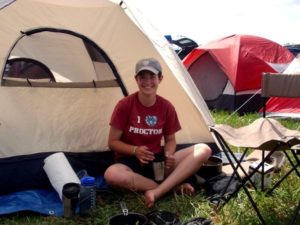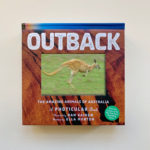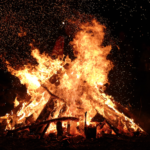 Like many kids who grew up in suburban New England, I spent a lot of my childhood outdoors. Yes, I did enjoy reading on the top bunk/bed-fort, but I also liked to climb the pine tree in my back yard and build enormous snow castles at the end of my driveway. (These were also good places to read.)
Like many kids who grew up in suburban New England, I spent a lot of my childhood outdoors. Yes, I did enjoy reading on the top bunk/bed-fort, but I also liked to climb the pine tree in my back yard and build enormous snow castles at the end of my driveway. (These were also good places to read.)
Despite a love of nature, I never once went camping as a child—at least not what I considered real camping. My parents weren’t (and still aren’t) really into the whole not-sleeping-in-a-bed thing, so they didn’t take me and my siblings on any trips that involved mosquitoes or canned food or “roughing it.” Another problem was my mindset: To me, camping required lots of gear, none of which we had. Okay, we had sleeping bags, but they were cotton and covered with pictures of Snoopy and the gang—no waterproof exterior, no thermal lining, more appropriate for the living room rug than the forest floor. We couldn’t cook a hot-dog or roast marshmallows because we didn’t have a camping stove, and our parents certainly wouldn’t allow us to start a roaring campfire without their help. And, probably the clincher, we didn’t even have a tent. Talk about pathetic.
Thinking back, I shouldn’t have felt so hopeless, because the truth is that I really did do a lot of camping, just not in the traditional sense. I never pitched a tent, but I did spend more than one night sleeping on a friend’s backyard trampoline. And roasting marshmallows was a bit of a Fourth of a July tradition in our neighborhood; granted, they were roasted over the barbecue, but the s’mores surely tasted just as sweet.
All this (phew!) to say that it’s August, and summer is winding down, and you should definitely give “real” camping a try if you’re able. Below is an excerpt from Camp Out!, the ultimate guide to camping for kids, that details the intricacies of finding the perfect spot for your tent, and what to do once you’re set up. And remember that you can still have fun even if the “perfect spot” for your tent just happens to be your living room.
 As for me, I still haven’t parked myself in the woods for a night, but I’ve come close the few times that I’ve gone to Bonnaroo, an annual music and arts festival in Tennessee. There am I in front of my tent with a real camping stove and a really large number of mosquito bites. Perfection.
As for me, I still haven’t parked myself in the woods for a night, but I’ve come close the few times that I’ve gone to Bonnaroo, an annual music and arts festival in Tennessee. There am I in front of my tent with a real camping stove and a really large number of mosquito bites. Perfection.
From Camp Out!: The Ultimate Kids’ Guide, by Lynne Brunelle
Location, Location, Location
No matter what type of tent you have, before you put it anywhere, think about the location in terms of water, sun, slope (is it on a hill or in a ditch?), ground surface, and wind. Tents are incredible contraptions, but they work best when smartly placed. After all, the tent is your outdoor bedroom; in some ways, it’s the most important room in the “house”!
- Stay dry. Though it may seem ideal to pitch your tent on the banks of a pretty lake or near that pond in your yard, you should always be at least 200 feet from any water. Being next to water can mean you’ll wake up drenched in dew. Water evaporates from the body of water and forms a cloud as the night air cools. Land around a body of water gets a bigger share of the moisture or dew. Also, water is where mosquitoes and other biting insects live, which means that if you’re near water when the sun goes down—insect feeding time—you’ll be on the menu for dinner. Instead, pitch your tent away from water. Find a well-drained spot that is on high ground and avoid dips and depressions—if you pitch your tent on low ground or in a dip and it rains, you’ll be snoozing in a puddle.
- Made in the shade. It’s usually best to put your tent in a shady spot, if possible, especially if you’ll be staying for more than one night. If the sun bears down on your tent all day, it will feel like an oven when you get back from frolicking in the woods. (Plus, too much sun exposure can weaken the fabric, making it more susceptible to tears and leaks.) If there are no trees around, try finding a natural feature that can block the sun, like a boulder.
- Be grounded. Seek out a smooth, flat patch that will fit your tent comfortably. If the ground slopes everywhere you look, you can still pitch your tent, but make sure you arrange it so your head will be uphill. Move away any rocks, large pebbles, sticks, or debris so you won’t be lying on top of them. But remember that this stuff isn’t garbage, it’s part of the environment—leave it nearby so you can replace it after you’ve taken down your tent. You want to leave a campground nicer than you found it, so the next family that comes by can enjoy it too.
- Fresh air. If you’re going to a car camping site with bathrooms, check to see where the camp toilets are and which way the wind is blowing. You want to be close enough to use the bathroom easily, but not so close you can smell it—after all, you want fresh air! If you’re in a remote area where you have to dig your own pit toilet, make sure you set it up at least 200 feet away from water, trails, and camp, and downwind (the wind direction might change, of course, but at least you gave it a shot).
- Don’t get winded. Choose a place that will be protected from the wind should it kick up. You don’t want your rain flap to fly around too much or blow away.
- Flee from fire. Pitch your tent a good distance from your fire pit and kitchen area. Fire makes sparks, sparks can land on tents, and sparks on tents can equal fire—which equals bad news. You also want to steer clear of pitching a tent near your kitchen or dishwashing area, because animals are attracted to the scent of food.
Settling In
Once your tent is set up, go on in and make yourself at home. Roll out your sleeping pad and sleeping bag and let them sit while you explore your site. Next, air out your tent, which can get a bit stuffy and funky-smelling: Open the windows, keep the screens closed, and let the air (not the bugs) flow through. If weather permits, leave your backpack or duffel bag outside the tent to maximize space inside. Cover it with a garbage bag so it doesn’t get soaked with morning dew.





2 Comments
Julies Roy
October 23, 2017 at 4:38 amLove your excellent post! I love to go to outdoor and stay a long time. I see your post, This post is really informative and helpful for all kids and pro explorer. I also like Camp Out!: The Ultimate Kids’ Guide. Thanks for your great efforts on this post. I recommend your post is best for all camp lover.
Adam James
August 11, 2020 at 7:13 amLove your excellent post!